The profile, or side view, of a dolphin, is the easiest to draw by the most difficult to describe. ;P Hopefully I did a fair enough job in the following steps to help you out.
Step 1
Draw a guideline (naturally!) and define the head region. Sketch lightly!!
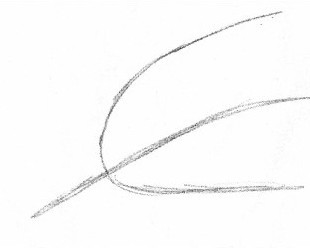
Step 2
Block in the beak, making it as long or as short as you want (within the realm of nature... discussed in other parts of this tutorial). Mark in the eye in the desired sport... I prefer to make mine about one and a half or two beak lengths away... above the guideline.
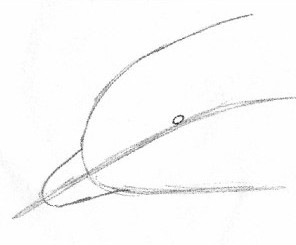
Step 3
Draw the brow ridge's crease from the top of the eye to where the rostrum (upper jaw) meets the melon. The line of the mouth follows the lateral line until about an eye length before the tip. At this point, the mouthline breaks and tilts upward, forming the rough knob at the front of the jaw that overlaps the top jaw. This is known as the gape.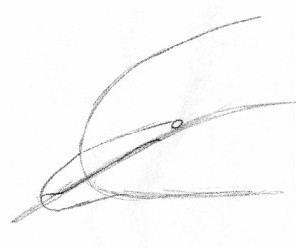
Step 4
Erase guidelines and add details such as facial markings and shading. Delphine facial structures are discussed in another part of this tutorial. The underjaw meets the neck and forms a slight crease as indicated by the arrow.
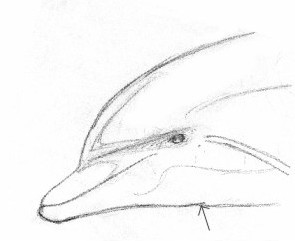
When drawing the head of a dolphin facing directly towards the reader, the principles of foreshortening come into play, making this view one of the most difficult to portray. In the following steps, I attempted to simplify the procedure.
Step 1
Draw a circle and divide it roughly into quarters. Sketch lightly!!! The horizontal line will be your eye-line.
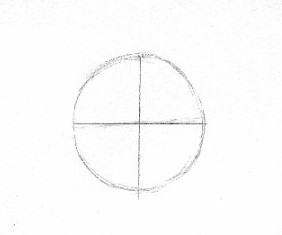
Step 2
In Step 2, draw another guideline just below the horizontal line already in place, shown here in red. This line will serve as the mouth. On your original horizontal guideline, divide each half into thirds. Draw a small oval where the vertical and mouth guidelines cross and make it as wide as the inner 1/3 marks. Place the eyes at just outside of the outermost tic marks.
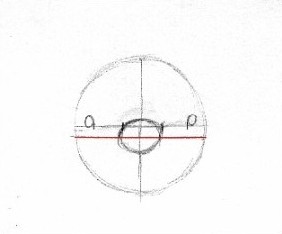
Step 3
Okay now it's going to get a little difficult. To draw the mouth, begin by drawing an arc that stretches from the innermost tic marks as shown. Then draw the rest of the "smile" as if completing a very flat "W". I also began to draw in a few form lines to define the melon and eye groove that parallels the mouth.
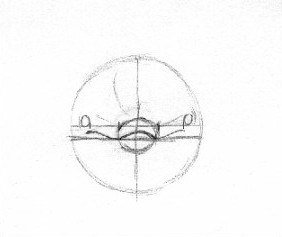
Step 4
Erase your guidelines and add details. To really make this view work it must be shaded to create the illusion of depth. Many dolphins tend to have stripes on their forehead. When defining the final structure of the head, remember that there is a slight bulge above each eye for the delphine equivalent of an eyebrow.
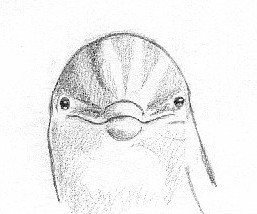
The "beak" of a dolphin is composed of two parts: the upper jaw, known as the rostrum, and the lower jaw, which generally has a thick knob at the end called the gape. The snout of a dolphin varies species to species and even within the species, creating a method in which to tell an individual apart from the other dolphins.
In the figure below, each of the dolphins' heads had the same eye placement and, which the exception of Figure E, the same melon. The only variation is the length, width, and shape of the beaks. In Figure A, the mouthline is curled into what appears to be a sneer. Many dolphins have this curl and have more wrinkles in the snout to form a "lip". Figure B shows a dolphin with a very thin lower jaw and large, pronounced gape. The beak in Figure C is about as short as they get in bottlenose dolphins and creates a cute, youthful appearance. The mouthline in Figure D is almost perfectly straight after the gape and has only the barest tilt at the anterior end. Figure E shows the beak about as long as I can stand. The beak rarely reaches this length in bottlenose dolphins as far as I have observed, but are quite normal for spotted dolphins and common dolphins. In spinner dolphins, they are even longer and thinner. I felt it was necessary to make the melon more angular in this case. Figure F shows a sharper beak, where the upper and lower jaw tapers more to a point. The dolphin in Figure G has the typical delphine smile and served as my template for all the other heads seen here. The smile in Figure G is as curved upward as can be allowed without repositioning the eye.
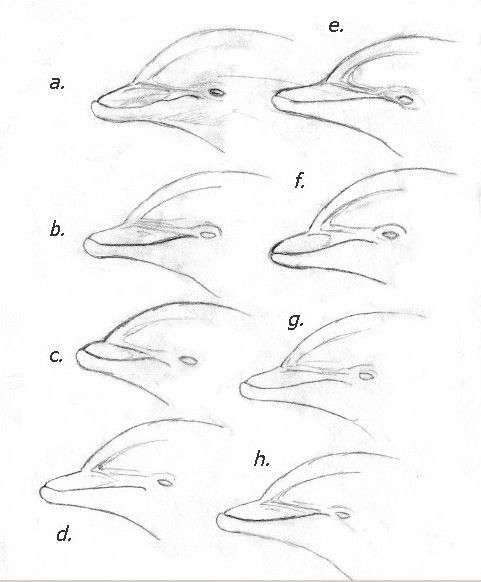
The beak is basically a tapered cylinder merging into the round wedge of the head. See? Now I'm not going to lie to you and say I have an easy time drawing the face of a dolphin at any angle.
Here is a show of a dolphin's open mouth. Take notes of the various features I pointed out. The black circles indicate highlight spots that you should consider memorizing.
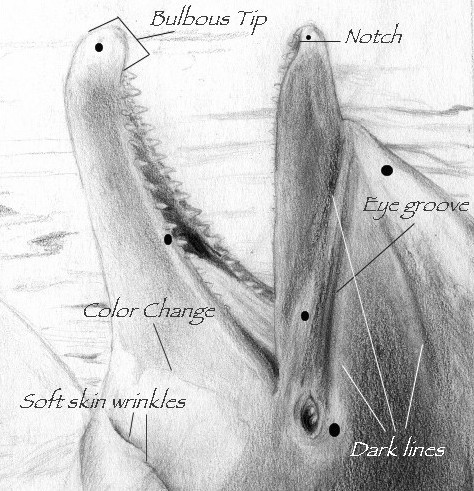
Now here's all the really cool, fun stuff. Wheee! After years of drawing 'phins, I have picked out many interesting tidbits of dolphin features, several of which have previously been mentioned in other parts of this tutorial.
Dorsal Fins
There are many different ways to draw dorsal fins. Some are pretty straight, others are extremely hooked, some are wide, others are thin, and still more are notched and scarred. Check 'em out!
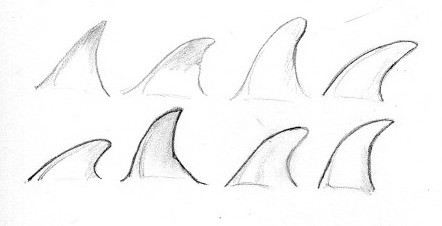
The Head and Face
The face of a dolphin has many dark markings, bumps, and creases. Check the following drawing:
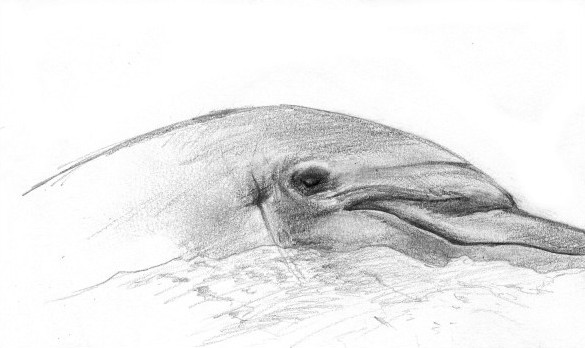
See the ear dimple? It's not always noticable, but if you draw close ups such as this one, be sure to at least suggest that it's there. Also note the wrinkles around the eye and beak. Also... see where the light catches the "lip"?
